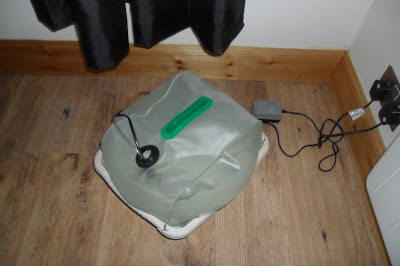 |
| Unidentified cyanobacteria 12-11-12 |
I noticed a new patch of cyanobacteria on the moss ball. It forms a coarser matt than my previous cyano and looks to be a different colour. The matt above took four days to form so it's quite lively. Once again it was microscopy time and, if I do say so myself, I took some great photos.
 |
| Three filamentous cyanobacteria species from a freshwater aquarium. The wide filaments may contain necridia (arrowed). Sample taken from a macroscopic matt growing on a moss ball. |
(Edit 7/9/14 see
Chapter22 for more recent cyanobacteria identification)
There are obviously three types of filament here. Species 1. looks a lot like the cyanobacteria in the unheated tank and that had previously dominated the tropical tank. I'll call the broad filaments species 2 and the small species 3. So back I went to
phycokey where I discovered that all three are probably Oscillatoria (filaments, un-branched, un-tapered, no heterocysts, no sheath, not spiral). The two arrowed cells above are probably not heterocysts. They look like this diagram from an algae identification guide I found.
The clear cells are the separation discs (necridia). These are the site of filament fragmentation giving rise to a hormogonium, which is how some species of Oscillatoria reproduce. But not all Oscillatoria it seems as I have never seen necridia in my species 1 (note the single cell 'filament' in
photo two Chapter VIII Appendix I).
 |
Species 2 is much more interesting to look at than species 1.
Note how dark the pigment in species 3 is, almost black. |
Given that the three species look so different and possibly reproduce differently, I thought maybe I could take a guess at which species I have (contradicting what I wrote in
Chapter VI Appendix I) . I found a guide to
identifying algae in water supplies that has a section on cyanobacteria and Oscillatoria in particular (thankyou The University of Texas). All I needed to do was measure the width of the filaments and the length of the cells that make up the filaments and It seemed I could follow the key.
Species 1. Filament diameter 2.0 micrometers (2 thousandths of a mm), average cell length 5.3 micrometers (L/W ratio 2.65). So, question one, are the cells half to equal or greater in length than the width of the filament? Answer yes. Question two, are the filaments red/purple? No. Question three, are the filaments blue/green? Yes. Question four, are the cells 2-3 times as long as the filament diameter? Yes. Question five, are the filaments tapered? At this point I am left with two choices. If I say yes I get
Oscillatoria splendida, if no
O. amphibia. The cell dimensions are correct for both so don't be put off
O. amphibia because the filament in the linked photo looks a different colour to mine. Microscope types make a huge difference to the images. So the question is, are species 1 filaments tapered? I will make two points. Firstly I can find photos annotated as
O. splendida with non-tapered filament ends (there's one in the main photo from the above link). Secondly, as I pointed out in
Chapter VI Appendix I, I observe a mixture of tapered and non-tapered filaments (admittedly non-tapered dominate). I suggested then that I might have a mixture of species, and if being tapered really is being used as a species defining characteristic in the genus, then perhaps I do. However, I have made a disturbing observation.
The filament marked has a tapered and non-tapered end and wasn't the only one I observed, although they are rare. I cannot find a filament that is tapered at both ends in any of my photos so I'm not sure tapering can be used to define these filaments. In summary, my best guess at the moment is that my tank was overrun by
O. splendida or
O. amphibia but I've got some reading to do to check how consistent tapering is in these species. Also, these might not be the only possibilities. The University of Texas guide doesn't cover all Oscillatoria species, only those found in water supplies. If you follow the
O. splendida link above you will see a related species that looks very similar but that is not mentioned in the key. Oscillatoria taxonomy is a contested area and I notice from
algaebase that out of 1049 species in the genus, only 60 are accepted taxonomically. I think this will be a work in progress.




























